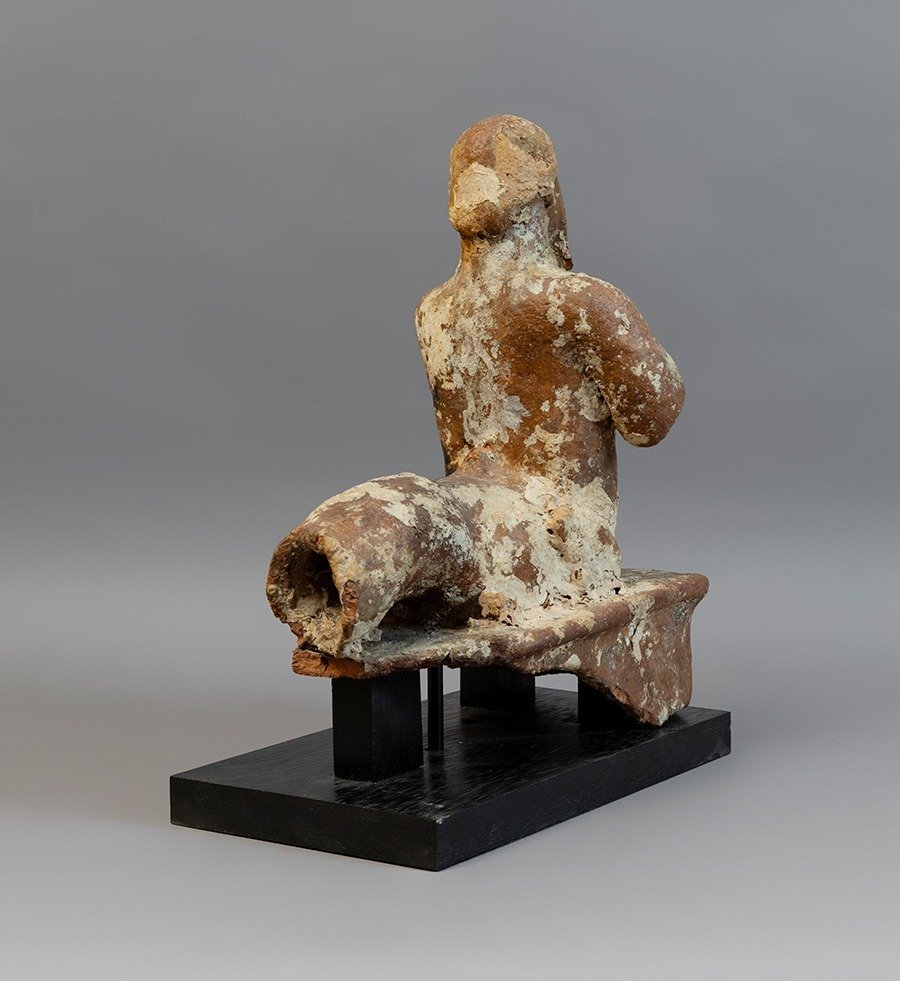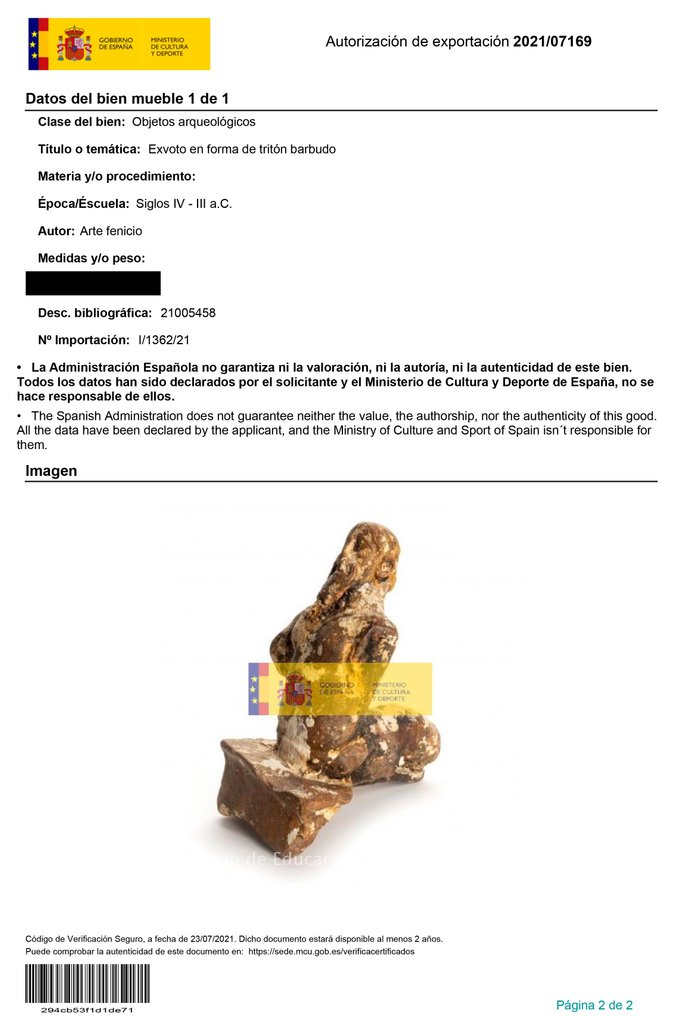Great object. Really beautiful. Quick delivery. Excellent.
Ver traduzidoFenício Terracota Ex-Voto ou Ídolo representando um Tritão. Séculos 6 a 4 aC. 32 cm H. Procedência antiga. Exportação
N.º 88181123






Important figure of an Ex-Voto or Idol depicting a Triton.
Phoenician, c. 6th - 4th century B.C.
32 cm H and 27 cm L. (without stand) 36 cm H with stand.
- STAND DISPLAY INCLUDED -
PROVENANCE: Maurice Druon Collection, Paris 1918 - 2009. Druon was a French writer and academic, Minister of Culture of France between 1973 and 1974.
CONDITION: Good state, see photos, unrestored.
DESCRIPCTION:
It is representing a Hybrid creature, the upper half being a man's body and lower half is a fish's body, specifically the tail.
It is presented on a base made in the form of an altar. The human torso is naked, with fine features such as the chest and the navel. The face has a serene expression with large almond shaped eyes highlighted by eyelids that are marked with a thick line, this being a Phoenician interpretation that is of clear Greek Archaïc inspiration.
At the height of the chin, there is a false beard, reminiscent of that used by the Egyptian pharaohs as a sign of power. The hair is worked in a smooth way, delimited in all its contour by a line of geometric design that frames the form of the man's head, this in turn links with the classic Greek tradition. In this way we can see how it is a piece that eclectically combines influences from styles such as Greek or Egyptian, the result of the Phoenicians' contacts with these cultures.
With respect to its iconography, it could be Yam, the god of the sea in the Canaanite pantheon. Yam is a deity of the sea and his palace is in the abyss associated with the depths. He represents the primordial chaos, the power of the sea, uncontainable and furious; he is seen as the god of dominant storms and the disasters they cause, and he was an important deity for the maritime Phoenicians.
This figure belongs to a group of Phoenician terracottas that remained 2,500 years under the sea until the 1960s when a fortuitous discovery made it possible to find all the pieces. One of the hypotheses that are being considered is that the Phoenicians, faced with the siege that the city suffered by Alexander the Great, loaded their ships with these pieces in order to escape from the city with their most precious goods. However, a storm must have surprised them a few kilometres from the coast, causing the ship to sink and the terracotta boats it contained to sink.
The sea god Triton, of Greek origin, is depicted on this Phoenician votive offering with a stylised face framed by a beard that gives him an aristocratic bearing. The muscular torso curves at the level of the hips, growing to the back with a long tail. He probably originally could have been blowing a conch shell. It follows Greek precepts in terms of representation, with the torso of a man and the lower part of a fish. Legend has it that Triton lived with his parents, Poseidon and Amphitrite, in a golden palace at the bottom of the sea. He is often depicted with a conch shell that he blows like a trumpet. The Phoenician culture, and later the Romans, inherited this figure and reinterpreted its symbolism. Here, adopting the role of an ex-vota, he gives good fortune to sailors.
Notes:
The seller guarantees that he acquired this piece according to all national and international laws related to the ownership of cultural property. Provenance statement seen by Catawiki.
The piece includes authenticity certificate.
The piece includes Spanish Export License.
THE MINISTRY OF CULTURE FROM SPAIN ASKS ALL SELLERS FOR INVOICES OR OTHER DOCUMENTATION ABLE TO PROVE THE LEGALITY OF EACH ITEM BEFORE PROVIDING AN IMPORT OR EXPORT LICENSE.
Mais sobre o vendedor
Important figure of an Ex-Voto or Idol depicting a Triton.
Phoenician, c. 6th - 4th century B.C.
32 cm H and 27 cm L. (without stand) 36 cm H with stand.
- STAND DISPLAY INCLUDED -
PROVENANCE: Maurice Druon Collection, Paris 1918 - 2009. Druon was a French writer and academic, Minister of Culture of France between 1973 and 1974.
CONDITION: Good state, see photos, unrestored.
DESCRIPCTION:
It is representing a Hybrid creature, the upper half being a man's body and lower half is a fish's body, specifically the tail.
It is presented on a base made in the form of an altar. The human torso is naked, with fine features such as the chest and the navel. The face has a serene expression with large almond shaped eyes highlighted by eyelids that are marked with a thick line, this being a Phoenician interpretation that is of clear Greek Archaïc inspiration.
At the height of the chin, there is a false beard, reminiscent of that used by the Egyptian pharaohs as a sign of power. The hair is worked in a smooth way, delimited in all its contour by a line of geometric design that frames the form of the man's head, this in turn links with the classic Greek tradition. In this way we can see how it is a piece that eclectically combines influences from styles such as Greek or Egyptian, the result of the Phoenicians' contacts with these cultures.
With respect to its iconography, it could be Yam, the god of the sea in the Canaanite pantheon. Yam is a deity of the sea and his palace is in the abyss associated with the depths. He represents the primordial chaos, the power of the sea, uncontainable and furious; he is seen as the god of dominant storms and the disasters they cause, and he was an important deity for the maritime Phoenicians.
This figure belongs to a group of Phoenician terracottas that remained 2,500 years under the sea until the 1960s when a fortuitous discovery made it possible to find all the pieces. One of the hypotheses that are being considered is that the Phoenicians, faced with the siege that the city suffered by Alexander the Great, loaded their ships with these pieces in order to escape from the city with their most precious goods. However, a storm must have surprised them a few kilometres from the coast, causing the ship to sink and the terracotta boats it contained to sink.
The sea god Triton, of Greek origin, is depicted on this Phoenician votive offering with a stylised face framed by a beard that gives him an aristocratic bearing. The muscular torso curves at the level of the hips, growing to the back with a long tail. He probably originally could have been blowing a conch shell. It follows Greek precepts in terms of representation, with the torso of a man and the lower part of a fish. Legend has it that Triton lived with his parents, Poseidon and Amphitrite, in a golden palace at the bottom of the sea. He is often depicted with a conch shell that he blows like a trumpet. The Phoenician culture, and later the Romans, inherited this figure and reinterpreted its symbolism. Here, adopting the role of an ex-vota, he gives good fortune to sailors.
Notes:
The seller guarantees that he acquired this piece according to all national and international laws related to the ownership of cultural property. Provenance statement seen by Catawiki.
The piece includes authenticity certificate.
The piece includes Spanish Export License.
THE MINISTRY OF CULTURE FROM SPAIN ASKS ALL SELLERS FOR INVOICES OR OTHER DOCUMENTATION ABLE TO PROVE THE LEGALITY OF EACH ITEM BEFORE PROVIDING AN IMPORT OR EXPORT LICENSE.
Mais sobre o vendedor
- 823
- 11
- 1
Superbe objet, Service d'Arqueologia Ancient Art excellent et rapide. Jaume Bagot toujours parfait .
Ver traduzidoTodo perfecto gracias
Ver traduzidoNice item all ok A+++
Ver traduzidoThank you for this Oinochoe, one question: did you as promised read my post!
Ver traduzidoExcellent translation, and very prompt delivery. Imperfect packaging. A significant crack of the board that had not been described in the original post of the item.
Ver traduzidoAlways a great pleasure!
Ver traduzidoFine quality, good service. Thanks.
Ver traduzidoMuy amables, muy bien todo. Gracias
Ver traduzidoAlles bestens
Ver traduzidoexactly as described and shipped safely and punctually.
Ver traduzidoschnelle Lieferung sehr sichere Verpackung alles bestens
Ver traduzidotres bel objet je le recherchai depuis longtemps envoi rapide et protégé je pense qu'il y aura d'autres achats avec ce vendeur merci +++++++
Ver traduzidoEinfach nur toll
Ver traduzidoTodo perfecto
Ver traduzidoottimo
Ver traduzidoperfetto
Ver traduzidotop oggetto bellissimo grazie 💯💯💯💯💯💯 :-)
Ver traduzidoI bought this beautiful artifact together with artifact from Mr. Bagot but although it is clearly stated on his shipping page that when purchasing multiple artifacts i paid the double package costs
Ver traduzidoI bought this beautiful artifact together with artifact from Mr. Bagot but although it is clearly stated on his shipping page that when purchasing multiple artifacts i paid the double package costs
Ver traduzidoBel objet, bien emballé. Parfait.
Ver traduzidowonderful faiece and very fast shipping.thanks a lot
Ver traduzidoJ Bagot es un profesional excelente. Sus artículos son de gran calidad, se incluye la documentación necesaria y el embalaje se realiza con esmero. Le recomiendo encarecidamente.
Ver traduzidoo envio foi bastante rápido, obrigado.
Ver traduzidoSono molto soddisfatto grazie.
Ver traduzido- 823
- 11
- 1
Great object. Really beautiful. Quick delivery. Excellent.
Ver traduzidoAviso Legal
O vendedor garante e pode provar que o objeto foi obtido legalmente. O vendedor foi informado pela Catawiki que tinha de fornecer a documentação exigida pelas leis e regulamentos do seu país de residência. O vendedor garante que tem o direito de vender/exportar este objeto. O vendedor fornecerá ao comprador toda a informação conhecida sobre a proveniência do objeto. O vendedor garante que serão ou já foram obtidas todas as autorizações necessárias. O vendedor informará imediatamente o comprador de quaisquer atrasos na obtenção de tais autorizações.
O vendedor garante e pode provar que o objeto foi obtido legalmente. O vendedor foi informado pela Catawiki que tinha de fornecer a documentação exigida pelas leis e regulamentos do seu país de residência. O vendedor garante que tem o direito de vender/exportar este objeto. O vendedor fornecerá ao comprador toda a informação conhecida sobre a proveniência do objeto. O vendedor garante que serão ou já foram obtidas todas as autorizações necessárias. O vendedor informará imediatamente o comprador de quaisquer atrasos na obtenção de tais autorizações.









